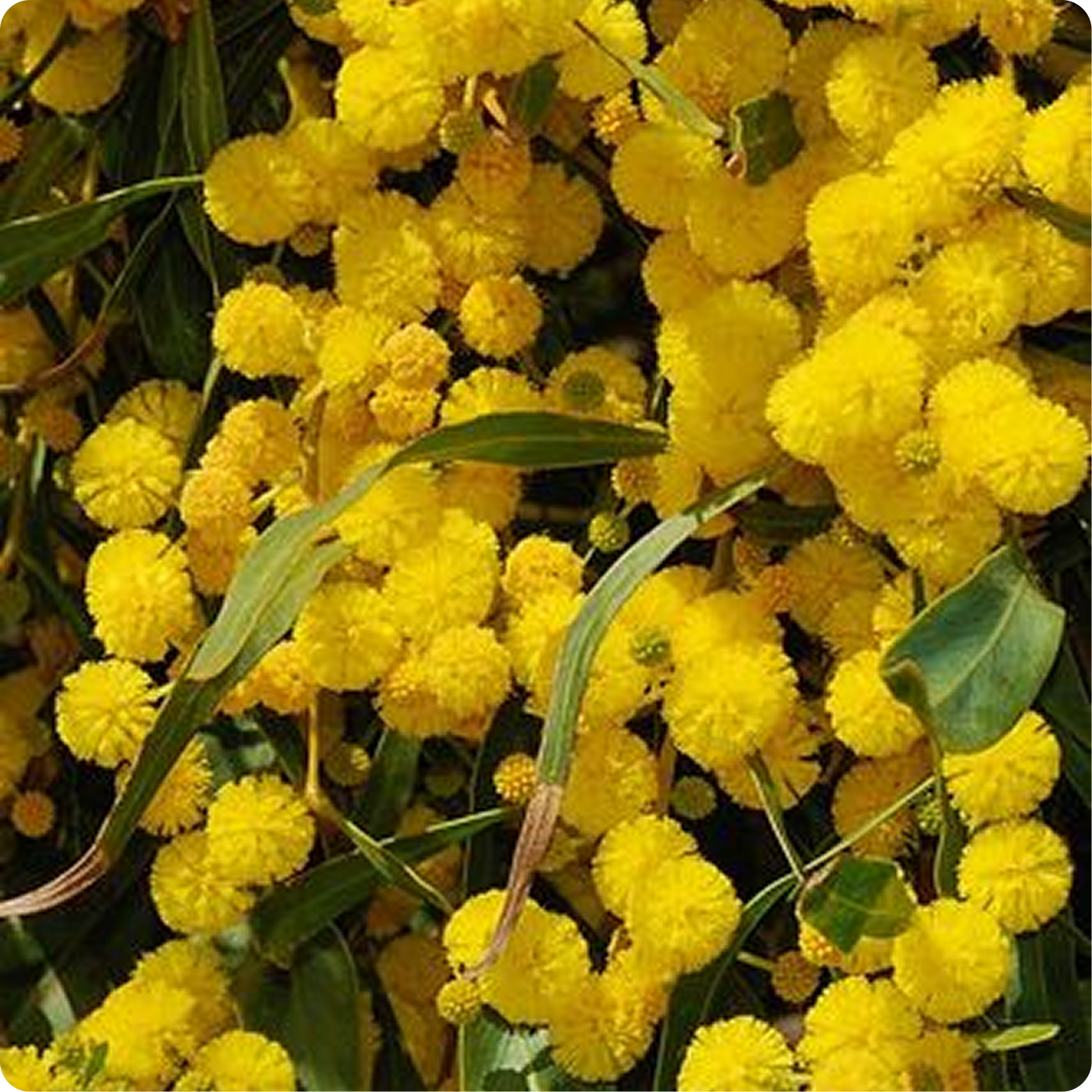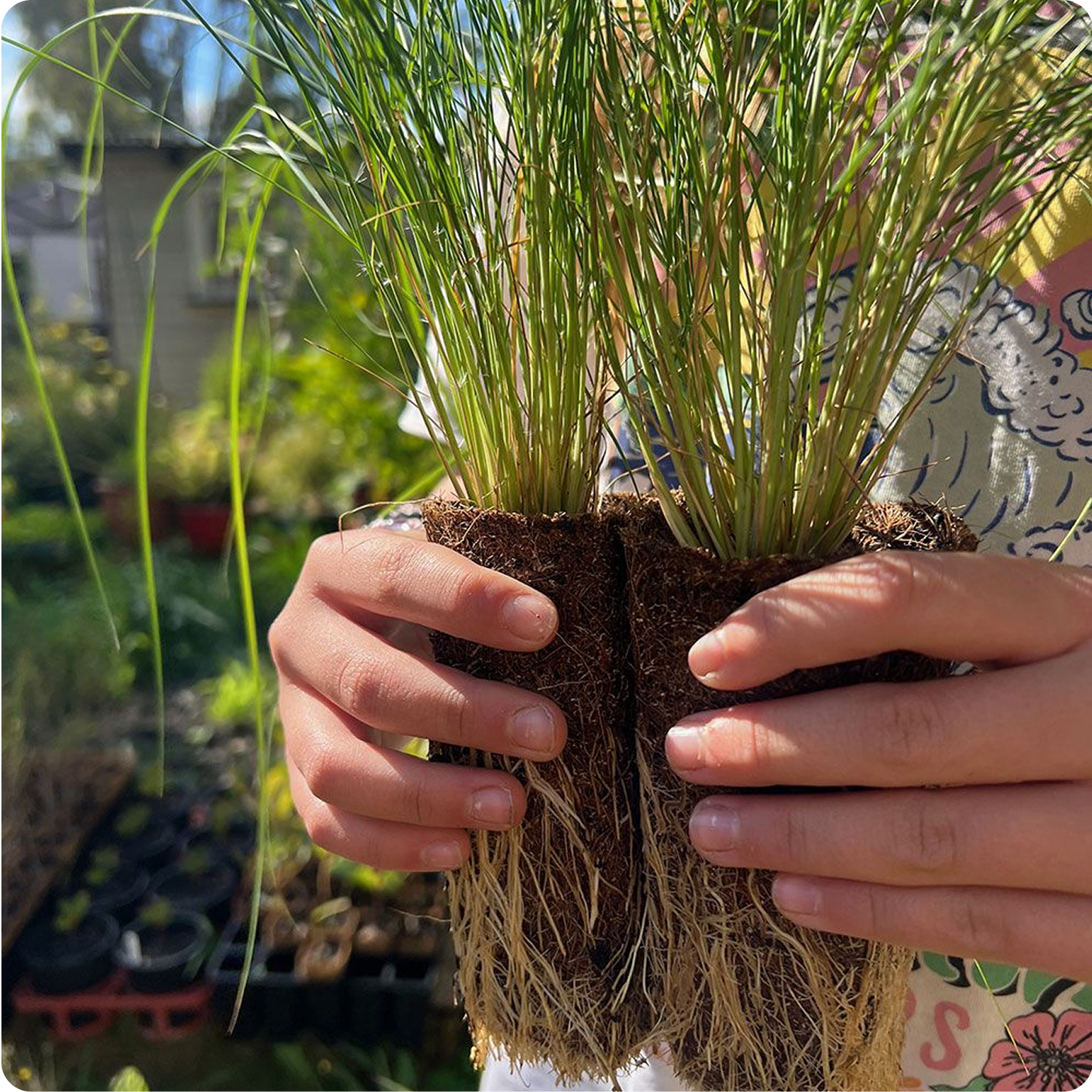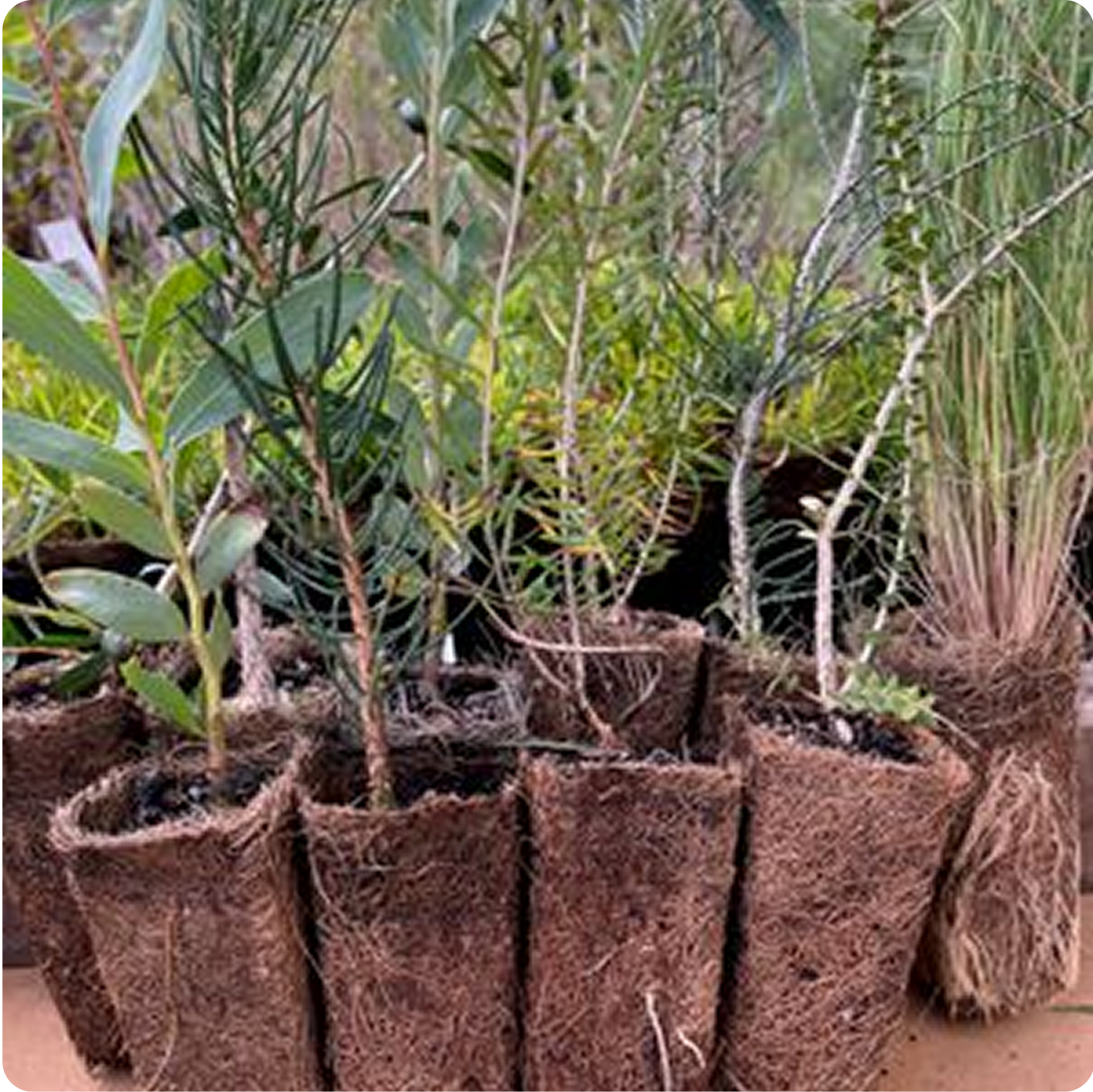Products
Sort by:
72 products
72 products
Acacia brumalis is a hardy, attractive acacia growing up to 3 metres. It produces dense foliage that offers shelter for birds and small wildlife, while providing masses of yellow flowers in winter and spring for bees and butterflies. Well-suited to many soil types, thrives in full sun and is drought tolerant once established.
A low maintenance, small bushy shrub perfect for native gardens, wind breaks and habitat.
Acacia daphnifolia has profuse yellow flowers in early winter, attracting pollinators. Adaptable to various soil types and pH levels, it's the perfect pick for anyone aiming to add a WA native plant into their garden.
Acacia daphnifolia roots enrich the soil by fixing nitrogen, fostering a healthier environment for all your garden's inhabitants. A medium shrub to 4 metres, it reshapes itself to fit its home, making any landscape design dream achievable.
You're also creating a haven for birds, pollinators, and other beneficial wildlife. Ideal for screening, wind protection and habitat corridors.
Enhance your landscape with the Acacia sessilispica, a dense, rounded shrub native to Western Australia. Growing to 3 metres, its pungent green phyllodes and golden flowers create a vibrant display from August to September. This hardy plant thrives in granitic loam and sandy soils, making it a resilient addition to your garden.
The Acacia sessilispica's inflorescences are a visual delight, with sessile spikes densely covered in pale to dark golden flowers. Blooming in late winter to early spring, these yellow blossoms add a burst of colour to any outdoor space.
Ideal for shrubland and mallee communities, Acacia sessilispica is perfect for adding structure and visual interest to gardens. Its angular, glabrous branchlets and glossy black seeds offer a unique aesthetic, while its robust nature ensures it withstands various environmental conditions, making it a versatile choice for any garden design.
Acacia meisneri, commonly known as the Blue Wattle. This eye-catching plant features vibrant yellow flowers and distinctive bluish-green foliage. Blooming in late winter to early spring, it's timed perfectly to attract pollinators and brighten your garden.
The Blue Wattle thrives in a variety of soil types, from sandy to loamy. It adapts easily, fast growing either as a small, charming tree or a dense, multi-stemmed shrub.
Acacia meisneri improves environmental health and beautifies spaces. It fixes nitrogen in the soil, its drought resistance also makes it suitable for landscaping, promoting a sustainable, water-efficient garden. Whether used as a natural screen or a decorative hedge, the Blue Wattle serves a dual purpose, enhancing both garden aesthetics and ecosystem health.
Eucalyptus kruseana, also known as the bookleaf mallee, is a unique and compact eucalyptus with striking silvery-blue, round foliage and decorative greenish yellow flowers. It grows as a straggly multi-stemmed mallee to 3.5m and has bark that sheds in ribbons. Adult leaves rarely form in the crown so it has only its juvenile leaves which give it it's unique character.
It has a sculptural form making it a favourite for florists and landscapers alike. Great in smaller gardens and easy to care for.
Eucalyptus thamnoides, or commonly known as the Brown Mallee, stands as a testament to the resilience and allure of the Australian wilderness, growing from 1.5 to 6 meters tall. Its bark a blend of pale grey and copper.
Blooming between March to July or November, these cream flowers are magnets for pollinators, enriching your garden with life and activity.
Thriving in diverse soils, it serves as a robust ecosystem guardian, offering shelter and sustenance to wildlife. Its rapid growth and drought tolerance make it invaluable for reforestation projects, acting as windbreaks and yielding essential oils.
Eucalyptus utilis, commonly known as Coastal moort, is a small, hardy mallee growing from 2-15m. It has a short trunk, branches with a spreading habit, smooth grey bark that peels off in ribbons revealing pale coppery bark beneath.
In late spring to summer it produces creamy white flowers that attract birds, bees and other pollinators. Adult leaves are thick, a shade of glossy olive green on both sides, egg-shaped to lance-shaped.
Eucalyptus utilis is highly tolerant of coastal winds, poor sandy soils, and drought, making it an ideal choice for coastal gardens, shelterbelts, wind breaks and habitat corridors.
Acacia cyclops, commonly known as coastal wattle or red-eyed wattle, is a hardy dome shaped shrub mostly found in coastal regions. It usually grows to a height of 4 metres but can get taller.
Its easily recognised by its bright yellow flowers, which are produced over a long time, from winter up until summer, and distinctive seed pods filled with seeds surrounded by a fleshy red aril - hence the name 'red-eyed'.
Acacia cyclops loves Perth sandy soils, where it is valued for its resilience and ability to improve soil fertility through nitrogen fixation.
Melaleuca hamulosa known as the "Creekline Honey Myrtle," is a shrub or small tree growing to usually 5 metres, with lance-shaped leaves and white bottlebrush-like flowers. It attracts pollinators like bees and birds.
This plant serves various purposes, including ecological roles such as providing habitat and food for wildlife, and ornamental use in landscaping and screening. It aids in land rehabilitation and erosion control, particularly in areas prone to erosion.
It thrives in wetter environments, like creek lines and swampy areas. Adaptable to various soil types, it contributes to soil health and stability.
Creeping Saltbush (Atriplex semibaccata), a robust plant that excels in stabilising soil and suppressing weeds. A low-growing, spreading ground cover reaching 1 metre across.
A dense low shrub with green/grey foliage and small, succulent red berries, which are diamond shaped, are food for birds. Atriplex semibaccata provides shelter and habitat for insects and lizards, grows in many soil types in full or part sun.
Discover the splendid Crimson Kunzea (Kunzea baxteri), a natural spectacle. Ideal for stand alone displays or screening, it's your tool for transforming any space into an enchanting landscape.
Kunzea baxteri flourishes in well-drained soils, full or partly shady position, perfect for Perth environments. Beyond its visual appeal, it promotes environmental well-being, fitting effortlessly into your garden.
Grows to 3m erect shrub, grey-green foliage and crimson profuse flowers clustered in 'bottlebrush' arrangement.
Eucalyptus drummondii, or Drummond's gum, is a compact and elegant mallee making it an excellent choice for Perth gardens. Usually growing to 3-7m, it can be grown in a small garden or several planted to fill a sunny spot.
It features smooth, mottled bark and attractive, blue-grey foliage, complemented by creamy/white flowers that start blooming in spring. This species is well suited to Perth's sandy soils and climate, thriving in full sun and drought tolerant once established.
Compact and attractive, Eucalyptus drummondii is ideal for native gardens, habitat planting or as a feature tree.
Enchylaena tomentosa, also known as barrier saltbush, is a hardy, low maintence native shrub perfect for tough conditions, thriving in many soil types, coastal areas and dry landscapes. Growing to 0.5-1m, barrier saltbush is resilient and adds great habitat value to your garden.
It's soft green foliage is complemented by vibrant red and golden berries which attract birds and wildlife to your space. Barrier saltbush is ideal for groundcover, erosion control and habitat.
Eucalyptus horistes, brings the essence of the Australian outback into your space. Its lance-shaped, glossy leaves are prized for their essential eucalyptus oils.
It grows as a mallee, erect and open, rising to a modest height of 4 to 10 metres, making it ideal to include in screening on your property. It adapts to various soil types, from sandy to loamy.
Flowering in late summer to autumn, its white to creamy blossoms play a crucial role in pollination and ecosystem enrichment, contributing to habitat restoration and erosion control.
Eucalyptus websteriana, commonly known as Webster's mallee, is a small tree growing to around 4 metres. It features a graceful, canopy of rounded heart shaped leaves and 'minni richi' bark, a peeling bark that reveals new bark underneath. In spring it produces clusters of yellow flowers that attract bees, birds and other pollinators to your garden.
Eucalyptus websteriana is hardy to dry conditions and poor soils, and the perfect tree for small spaces.
10 Perth local native plants
This mix includes 10 native species that grow between 1 and 3 metres tall. It’s ideal for creating habitat, shelter and food for birds and insects, adding soft structure to your garden, or creating understory. The selection supports local birds, bees, and other pollinators.
What’s included:
- 10 plants, grown in biodegradable coir pots
- All species are native to the Perth hills & surrounds
- Plants are suited to sandy soils and dry summers
- Selected for habitat value, resilience, and varied flowering seasons
Why native plants?
Local natives need less water, don’t need fertiliser, and help restore ecological balance. They’re a low-maintenance way to build biodiversity into your space.
What varieties are included?
Melaleuca acuminata (mallee honeymyrtle), Melaleuca brevifolia (mallee myrtle), Melaleuca lateritia (robin redbreast), Melaleuca fulgens (scarlet honeymyrtle), Melaleuca cordata, Kunzea baxteri (crimson kunzea), Kunzea recurva (purple kunzea), Acacia celastrifolia (grey myrtle wattle), Acacia brumalis, Acacia trigonophylla, Acacia hemiteles, Acacis daphnifolia, Calothamnus gilesii, Calothamnus rupestris (mouse ears), Maireana brevifolia (small leaf bluebush), Atriplex semibaccata (creeping saltbush), Allocasuarina campestis, Eucalyptus kruseana (bookleaf mallee)
Discover the Glowing Wattle (Acacia celastrifolia), it has golden prolific flowers in late winter into spring, large round leaves and is found in all bush land and gardens in the Perth area.
Flourishing in sandy to gravelly soil types, its dense foliage and deep roots not only create a lush landscape but also support a sustainable environment.
The Glowing Wattle plays a crucial role beyond aesthetics. It serves as a good screening plant, enhances soil quality through nitrogen-fixation, and serves as a haven for wildlife.
Transform a garden corner into a vibrant display with the Melaleuca radula also known as Graceful Honey Myrtle. This small shrub (1-2m) has evergreen leaves and profuse brush flowers that span from pink or purple.
The plant attracts bees, butterflies, and birds with its nectar-rich flowers, enriching local wildlife. It’s found in all bushland around the Perth area and north to Geraldton.
Thriving in various soil types and requiring little water once settled, the Graceful Honey Myrtle flourishes in both full sun and partial shade. Its drought tolerance and adaptability to different soils make it a low-maintenance yet stunning garden addition, ensuring year-round allure.
Showing 20/72












































